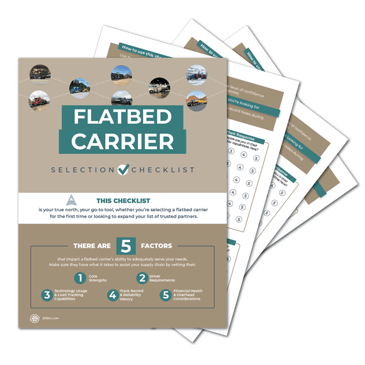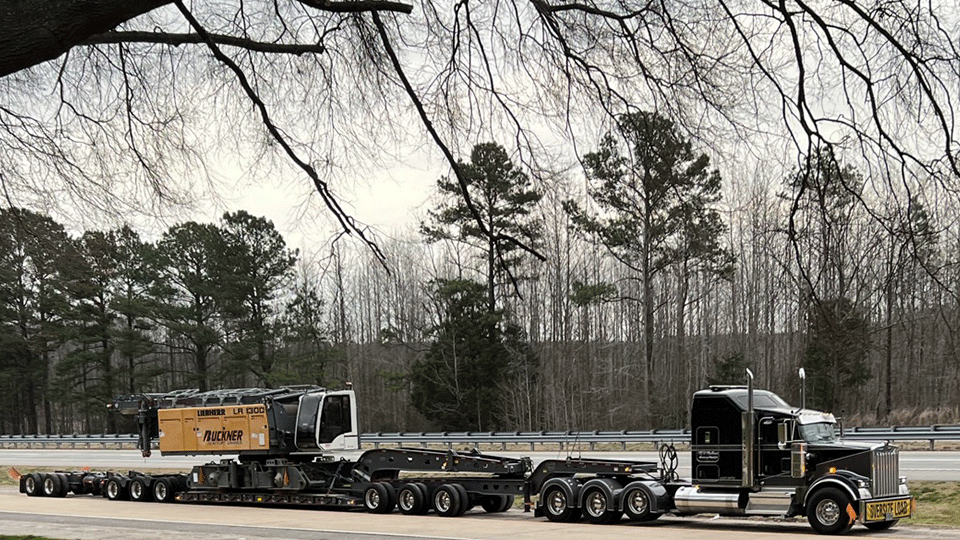 Shipping construction equipment is a complex task that demands precision, planning, and an eye for detail.
Shipping construction equipment is a complex task that demands precision, planning, and an eye for detail.
For shippers dealing in these rugged pieces of heavy machinery and equipment, ensuring their safe and timely arrival is crucial to maintaining operational efficiency and avoiding costly delays.
However, even experienced shippers can make mistakes that lead to damage, delays, and financial losses. It's great to learn from past mistakes — but wouldn't it be better to avoid making them altogether?
When it comes to effectively and safely moving your construction equipment, there’s no reason for you to stumble over common pitfalls when there's a depth and breadth of expertise at your disposal.
Here at Anderson Trucking Service (ATS), we’ve spent decades helping businesses across the U.S. move their construction equipment and machinery. Whether it’s to a job site, dealership, or a port, the years we’ve spent moving construction equipment have helped us refine our knowledge of these intricate processes.
In an industry as complex as transportation, however, expertise and refinement are earned through mistakes, adjustment and plenty of caffeine.
Below you’ll find an outline of the seven most common mistakes shippers make when moving their construction equipment and some advice to help you avoid doing the same.
The seven mistakes shippers make when moving their construction equipment are:
- Utilizing inappropriate trailer types
- Working with inexperienced, underqualified providers
- Assuming that a transportation provider is aware/capable of driving equipment onto/off of their trailer
- Making assumptions about transit times
- Operating with poor job site conditions
- Providing little lead time with high service requirements
- Not knowing and providing all pertinent cargo details
Mistake #1: Utilizing Ill-Suited Trailer Types
The transportation industry hoists a large burden; everything, from raw materials and paper products to retail goods, food and structural steel, has to get from A to B at least once during its lifetime. When that time comes, transportation companies answer the call.
For what it’s worth, the transportation marketplace has gotten really good at what it does. Local, regional and national trucking companies constantly strive to improve their offerings and cater their services to customer supply chains.
Great carriers do this by investing in the things that make each customer's life and transportation experience easier. While new technologies, employee training and improved in-house resources often top this list, carriers also invest heavily in their equipment (tractors, trailers, straps, tarps, etc.).
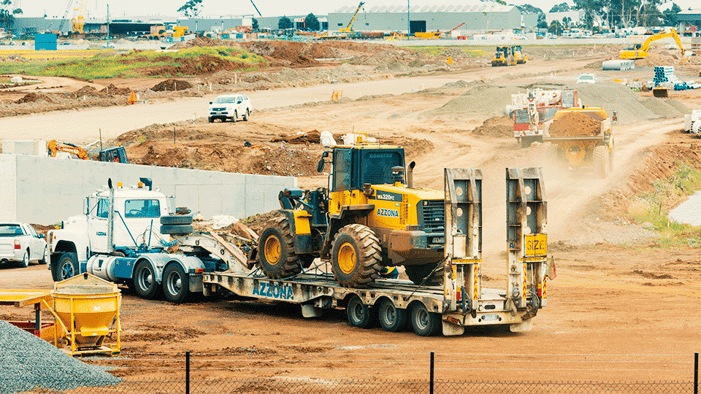
When moving construction equipment and machinery, little can be done about the size of this cargo as the majority of it is “non-divisible.” That said, there is an abundance of specialized trailers in the transportation sphere, designed to move construction equipment and machinery safely, securely and cost-effectively.
Without recognizing this, or the profound impact a best-fit trailer can make, shippers with these loads end up making a mistake, paying for things like cranes and unloading crews unnecessarily.
You see, the most seasoned construction-industry transportation providers have fleets of trailers designed for expeditiously moving these goods.
Examples of these trailer types include:
Removable gooseneck (RGN) trailers:
Great for shipping larger, self-propelled heavy machinery and equipment like excavators, forklifts, trenchers and pipelayers.
Step-deck trailers with ramps:
Simply drive machinery like mid-sized bulldozers, backhoe loaders and skid steers up the ramp of a step-deck trailer and avoid needing to load via crane.
Trailers with outriggers:
Commonly found on lowboy, double drop and other heavy haul trailers, outriggers act as an extension of the trailer for hauling heavy pieces of machinery — increasing it in width and/or length to support oversized equipment.
For construction equipment transportation, three common types of outriggers are used: swing out, pull out and attached outriggers.
Beam trailers:
Utilizing these trailers, where the construction equipment straddles a beam, allows a carrier to move large construction equipment at a lower loaded height, decreasing costs and risk in the process.
Related: Step-Deck Vs. Lowboy Trailers: Which is Best For Your Freight?
How to Avoid Using The Wrong Trailer
Avoiding this mistake will take some expertise. With so many options to choose from and little information outlining the primary use-cases of each, selecting the right trailer for your specific equipment should be done with a seasoned provider’s help.
The best trucking companies have teams of well-versed transportation professionals. These are individuals that help businesses, like yours, move their construction machinery and equipment every day, making them true experts at doing so.
Reach out to your preferred carriers and be specific about the dimensions and specifications of your equipment by outlining:
- Your equipment’s make, model and serial number
- Any and all attachments
- The exact type of equipment you need moved (include photos if possible).
- If the equipment has been modified, provide weight and dimensions
With this information in hand, great carriers will be able to arrange your best-fit solution with ease.
Mistake #2: Working With Inexperienced, Underqualified Providers
Transporting construction equipment like backhoes, dozers and excavators is anything but simple. Doing this effectively takes a firm understanding of the rules and regulations governing these shipments.
You see, unlike dry van or legal flatbed shipments, moving construction equipment (which is often “oversized” in some way) is a far more intricate process.
Although this is by no means a comprehensive list, some added complexities that accompany many construction equipment moves are:
- Divisibility rules and regulations: If your equipment is oversized, is it legally classified as divisible? If so, you’ll need to separate your load. If your equipment is non-divisible, permits will need to be acquired.
- Permitting rules and regulations: Every oversized, non-divisible shipment must have the appropriate permits in order to be moved. That said, getting oversized permits for your freight can be challenging and time-consuming without the right information (city, county, state laws) and resources.
- Route planning: The route your shipment ventures can significantly impact both its delivery timing and transportation costs. Since oversized permit prices vary from one area to the next, it’s crucial that your route is planned as cost-effectively as possible.
Additionally, at certain times of the year, in various areas of our country (like spring in the north), travel restrictions take effect — limiting the maneuverability of over-dimensional cargo throughout them.
Without understanding these intricacies, and having the in-house resources to navigate them, many carriers struggle to meet their customer commitments.
In turn, leaning on the experience of these underqualified providers can cause project delays when repeated setbacks occur on your equipment’s transport.
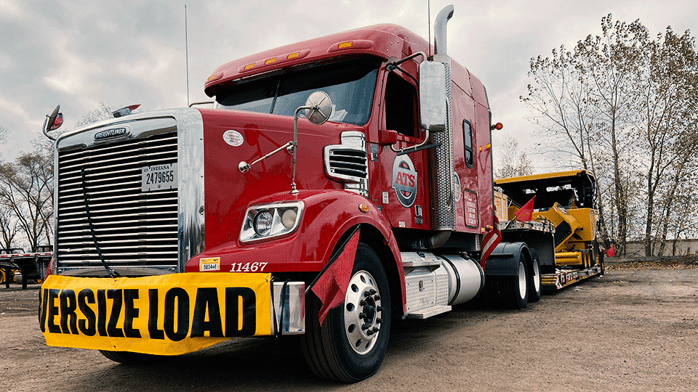
How to Avoid Using Inexperienced, Underqualified Providers
This mistake must be avoided at the vetting stage of your carrier selection process.
Too often, the transportation industry’s unpredictability and price instability lead companies to choose a carrier based purely on price.
Your provider selection decision should never be based solely on price — or any metric alone.
Instead, finding the best carriers for your construction equipment will take due diligence and a commitment to asking the important questions.
Some questions to prioritize when vetting your next carrier are:
- What kind of construction equipment do you typically move?
- What is your experience moving my type of equipment?
- What kind of specialized trailers do you have that fit my cargo?
- What is your process for acquiring permits? Do you have an in-house team?
- How many of your drivers have experience hauling over-dimensional freight?
At the end of the day, confidently accepting the guidance of your transportation provider will be incredibly valuable to your construction equipment moves. Make sure they have the experience and qualifications you deserve.
Need help vetting your next provider? Download the Flatbed Carrier Selection Checklist for free today!
Mistake #3: Assuming That a Transportation Provider is Aware and Capable of Driving Equipment Onto/Off of Their Trailer
No matter what kind of freight you need to be moved, confusion for one or more parties has the potential to create lasting issues, cargo damage, missed timelines and service failures.
For construction equipment transportation, miscommunication and confusion are particularly impactful.
Making assumptions about which party will maneuver a piece of construction equipment onto a trailer for transport and/or off of that trailer at a destination can quickly unravel a shipment.
Unless you’re delivering to or loading at a port, it’s never recommended to assume that your carrier’s truck driver will be responsible for, or have the ability to, drive your construction equipment onto/off of its trailer.
However, many shippers make this error.
You see, although truck drivers are experts at operating their vehicles, many of them aren’t comfortable or capable of safely moving construction equipment.
As such, expecting drivers to handle this portion of the transportation process — without stipulating as much upfront — can cause delays and (in the worst scenarios) significant cargo damage and liability issues.
Note: Construction equipment that is delivering to, or loading at, a port faces different realities; in most cases, drivers are required to maneuver this equipment — a fact that is not lost on great providers.
If your construction equipment will need to be operated at a port, great carriers will ensure a properly-trained driver is responsible for this load.
How to Avoid This Issue
To avoid this issue, communication will be your greatest ally.
Make sure your transportation provider is aware that their trucker will need to drive your equipment onto its trailer. With this information, your carrier can take steps to ensure that the driver on your shipment has the skills to safely meet these needs.
In turn, proper upfront communication will help you avoid costly delays that may occur when a driver arrives at a pickup only to learn they’ll be responsible for operating your equipment.
Many carriers employ drivers that have these skills and as long as they know about your requirements, you should have no trouble getting that equipment loaded.
Mistake #4: Making Assumptions About Transit Times
Construction equipment routinely requires permits in order to move it. And, more often than not, permitted loads take longer to transport than legal shipments due to a number of factors (i.e. the most cost-effective route isn’t always the most direct, acquiring permits takes time, escort services slow things down, etc.).
However, some shippers fail to consult their transportation provider on the estimated transit times of these loads. Instead, less-experienced companies make assumptions about how long these shipments will take, causing them to rely on, and make plans around, something that’s simply not realistic.
In the end, these ill-formed assumptions cause issues for all stakeholders (shippers, consignees, on-site workers, carriers), creating costly delays.
It’s difficult to plan out your shipment successfully without the right expectations for transit speed and arrival time.
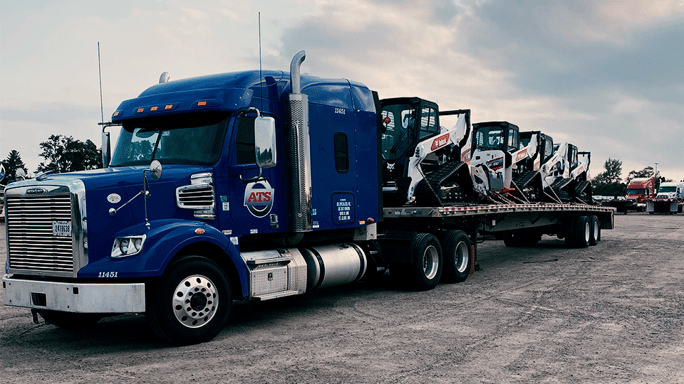
How to Avoid Making Incorrect Transit Time Assumptions
Lean on the expertise of your transportation provider and give them the information needed to formulate accurate transit timing estimates including:
- When and where your shipment needs to pick up (city, state, address, zip code)
- Where your shipment needs to deliver (city, state, address, zip code)
- Equipment make, model, serial number.
- Machine weight, width, length and height
- Don’t forget to include added attachments
With these insights, your carrier will be able to formulate a comprehensive route and transportation plan for your construction equipment — plan a best-fit route, line up permits, secure escorts and conduct a route survey (if necessary).
In turn, you’ll be far better suited to inform stakeholders on when they should expect a shipment to arrive so that they can plan accordingly.
Mistake #5: Having Poor Jobsite Conditions
For open-deck trucking companies and their drivers, understanding what they’re getting into before they arrive at a location is crucial.
With information as to what they’ll be asked to do on site (where to park, tight turns to note, difficult places to maneuver, steep grades to maneuver) they can plan accordingly.
Without this notice, however, sometimes shipments going to construction face delays and cause frustrations for all who are on site.
You see, every driver, like every job site, is different; each has different experience levels, skill sets and priorities. And, should an unexpected tight turn or winding road to back down at a location leave them feeling wary, or with concerns over the health of their equipment, they may opt away from doing so.
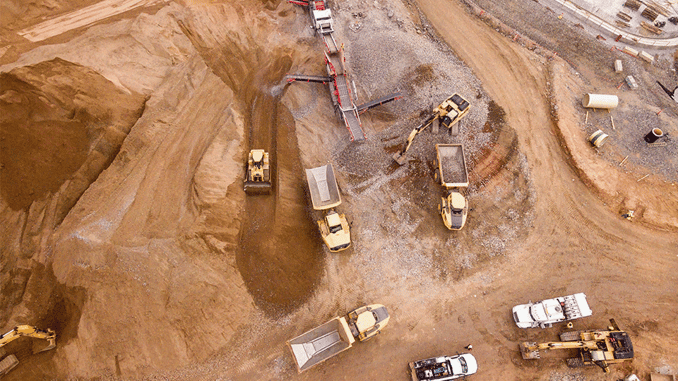
As you can imagine, having a truck show up to an origin/destination location and then leaving without your equipment (or refusing to offload it), due to one of these issues, can set your timelines back.
For this reason, it’s crucial that all of these intricacies are communicated before a driver arrives — consider sending over a site map with dimensions pointing out where the driver needs to go.
How to Avoid This Issue
Transparency will help you here. Even if you’re on the fence about whether to share information regarding maneuverability issues, we’d recommend you do so.
Take advantage of the assigned point of contact at your transportation carrier by sending them site maps that highlight hard-to-maneuver areas.
The more information you include, the better off you’ll be. With this knowledge, your trucking company will be able to find a more experienced driver if necessary, helping you avoid the unnecessary delays this issue can cause.
Mistake #6: Providing Little Lead Time With High Service Requirements
In the transportation industry, urgency usually equates to increased costs, shoddier planning and fewer service options for shippers. This pattern holds true when moving construction equipment — which requires a good amount of planning, notice and oversight to execute successfully.
That said, sometimes businesses fail to give their transportation providers the lead time necessary for getting the correct pieces in place to move their equipment.
Instead, these companies are shocked when they’re unable to secure the service levels they desire on short notice. But, with so many other things on their plate and commitments to meet, trucking companies have little ability to help these shippers move their freight on short notice.
And, since construction equipment freight moves are such specialized processes — difficult to get right in the best of times — urgent requirements are nearly impossible to meet.
As a result, companies that make this mistake find themselves in the unfortunate position of having to adjust their timelines or, pay extra to secure a reliable solution.
How to Avoid This Issue
To avoid service failures and heightened costs due to a lack of lead time, you’ll want to budget your time effectively.
Although it will vary based on the complexity of your load, give your transportation carrier 48-72 hours of lead time to schedule a qualified driver with the right trailer to move your equipment.
That said, if you have a strong, ongoing relationship with your carrier, it may also be worth consulting them on what an adequate lead time means for them. Often, shippers find value in optimizing their processes to a carrier’s capabilities, this is one opportunity to do so.
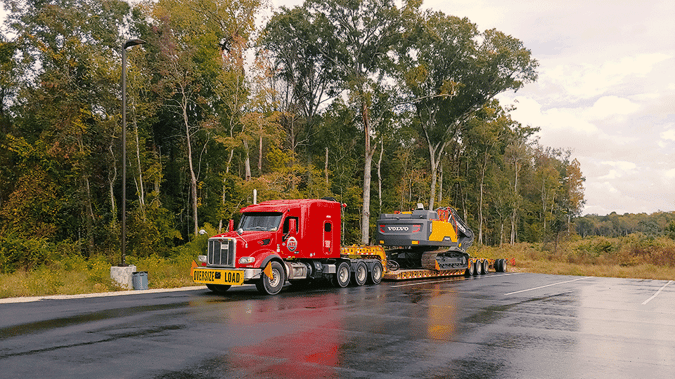
Mistake #7: Not Knowing and Providing All Pertinent Cargo Details
To ensure your equipment is handled, secured, protected and transported properly, your trucking company needs to thoroughly understand its specifications.
Sometimes, though, carriers are asked to haul a piece of equipment without these details.
Although things like equipment dimensions, weight and the type of machinery are important, and help carriers formulate a plan of action for moving it, knowing (and providing) your equipment’s serial number, make and model, are even more crucial as they’re legally required for transport.
Not having make, model and serial number information on hand, can lead to a fine for the carrier hauling these loads. For this reason, when shippers don’t give their carrier this information — either because they don’t know it or otherwise — see their shipment stall until this information is collected and communicated.
In the end, this can lead to prolonged delays and added costs, particularly if permits need to be renewed and/or deadlines need to be adjusted.
How to Avoid Delays Due to Missing Information
This will get easier with repeat exposure and experience. As the frequency with which you move construction equipment increases, and your carrier network becomes accustomed to your equipment and needs, providing all the necessary information will become second nature.
That said, in the beginning, avoid this mistake by consulting the point of contact at your trusted transportation provider. Ask this individual what information they’ll need to move your shipment expeditiously and legally. Jot down the information they give you and make sure to provide these insights with each pickup you request in the future.
Always remember this: when it comes to getting your construction equipment moved, there’s no such thing as too much information.
Avoid All of These Mistakes By Using Great Carriers
Now that you understand seven of the largest mistakes shippers make when moving their construction equipment, and have some tactics for avoiding each of them, you also know how crucial using great transportation providers is to this process.
However, if you’ve spent any time in the transportation world you’ve seen the sheer number of carriers shippers have to choose from — a fact that intimidates many companies.
What should you look for when adding carriers to your network?
Are there things you should prioritize throughout your vetting processes?
Is it possible to ensure your carrier has the capabilities you’re looking for before ever handing them a load?
Each of these questions, though important, is rarely answered in the transportation industry.
Here at ATS, we’ve developed a tool to help you through this process. Download the 36-question Flatbed Carrier Selection Checklist, a free tool created to help you select your best-fit carrier partnerships the first time, and wave goodbye to shoddy carrier relationships and costly service failures.
Finally, if you’d like to learn more about ATS’ construction equipment transportation services and the steps we take to ensure every shipment is delivered safely, securely and on time, check out our Construction Services page for some more information.
